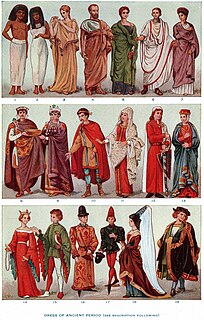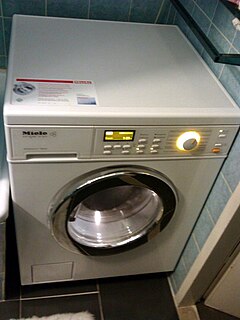
Clothing is a collective term for items worn on the body. Clothing can be made of textiles, animal skin, or other thin sheets of materials put together. The wearing of clothing is mostly restricted to human beings and is a feature of all human societies. The amount and type of clothing worn depend on body type, social, and geographic considerations. Some clothing can be gender-specific.

A clothes line or washing line is any type of rope, cord, or twine that has been stretched between two points, outside or indoors, above the level of the ground. Clothing that has recently been washed is hung along the line to dry, using clothes pegs or clothespins. Washing lines are attached either from a post or a wall, and are frequently located in back gardens, or on balconies. Longer washing lines often have props holding up sections in the middle due to the weight of the usually wet clothing.
A fabric softener is a conditioner that is typically applied to laundry during the rinse cycle in a washing machine. In contrast to laundry detergents, fabric softeners may be regarded as a kind of after-treatment laundry aid.

A dress shirt, button shirt, button-front, button-front shirt, or button-up shirt is a garment with a collar and a full-length opening at the front, which is fastened using buttons or shirt studs. A button-down or button-down shirt is a dress shirt which has a button-down collar – a collar having the ends fastened to the shirt with buttons.

A combo washer dryer is a combination in a single cabinet of a washing machine and a clothes dryer. It should not be confused with a "stackable" combination of a separate washing machine and a separate clothes dryer.
Layered clothing is a term describing a way of dressing using many garments that are worn on top of each other. Some of the layers have different, largely non-overlapping, functions. Using more or fewer layers, or replacing one layer but not others, allows for flexible clothing to match the needs of each situation. Two thin layers can be warmer yet lighter than one thick layer, because the air trapped between layers serves as thermal insulation. Layered clothing is particularly relevant in cold climates, where clothing must at the same time transfer moisture, provide warmth, and protect from wind and rain. In a hot and dry climate, clothes have very different functional requirements: they must block the radiation from the sun, and allow for sufficient air circulation. Therefore, layered clothing in the sense used in this article is largely irrelevant in hot and dry climates. The wicking layer moves the sweat from your skin, where it can be absorbed by the other layers.

Ruth Mary Rogan Benerito was an American chemist and inventor known for her work related to the textile industry, notably including the development of wash-and-wear cotton fabrics. She held 55 patents.
Craghoppers is a British outdoor clothing manufacturer and supplier that was founded in Batley, West Yorkshire in 1965. It is best known for its walking gear Kiwi range.

Dazzle is a type of polyester fabric that is widely used in making clothes such as basketball uniforms, football uniforms, rugby uniforms, and casual clothing, because it absorbs moisture quickly. It is a lightweight fabric that allows air to circulate easily around the body.

Ironing is the use of a machine, usually a heated tool, to remove wrinkles from fabric. The heating is commonly done to a temperature of 180–220 °Celsius, depending on the fabric. Ironing works by loosening the bonds between the long-chain polymer molecules in the fibers of the material. While the molecules are hot, the fibers are straightened by the weight of the iron, and they hold their new shape as they cool. Some fabrics, such as cotton, require the addition of water to loosen the intermolecular bonds. Many modern fabrics are advertised as needing little or no ironing. Permanent press clothing was developed to reduce the ironing necessary by combining wrinkle-resistant polyester with cotton.

Lint is the common name for visible accumulations of textile fibers and other materials, usually found on and around clothing. Certain materials used in the manufacture of clothing, such as cotton, linen, and wool, contain numerous, very short fibers bundled together. During the course of normal wear, these fibers may either detach or be jostled out of the weave of which they are part. This is the reason that heavily used articles like shirts and towels become thin over time, and why these particles collect in the lint screen of a clothes dryer.
Spray-on clothing is a form of clothing, that is applied by spraying polymer over the body in such a manner that it appears as clothing. It is a polymer mix that dries relatively quickly.
Thai Fabrics are Thai handicraft products that are indicative of the flourish of the Thai national culture and creativity of the nation in making products and clothes for daily use. Thai Fabric is hand-woven fabric produced in Thailand. It is a cultural heritage and unique culture to the Thai culture and now has been famous throughout the world.
A non-iron shirt is a shirt woven from wrinkle-resistant fabric to reduce the need for ironing. While fabric cleaning and maintenance may be simplified, some wearers experience descreased comfort.
















